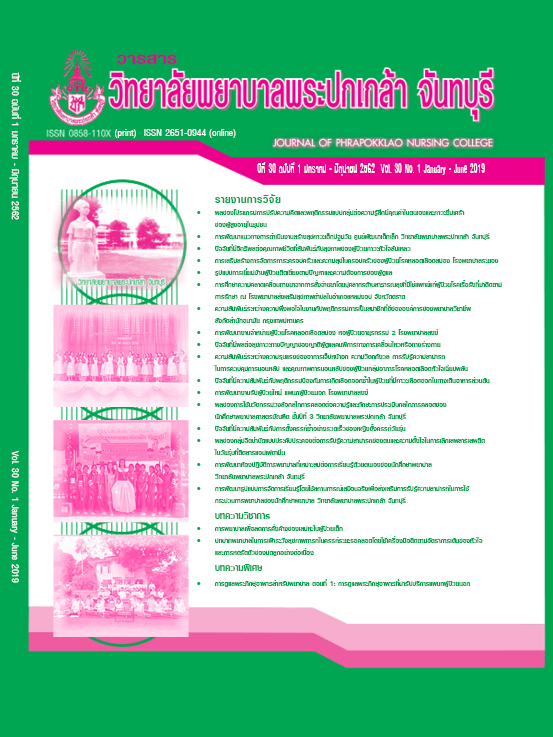A Development of Stroke Patient Discharge in Medical Ward 2 at Priest Hospital
Keywords:
Discharge plan, Stroke, Model developmentAbstract
This experimental development research aimed to develop a new working model of stroke patient discharge in medical ward 2 at Priest Hospital using the existing resources. The samples consisted of 2 groups; one group was the discharge planning activities in an experimental area (17 times) and a control area (13 times), another group was person regarding stroke patient discharge included administrators, service providers, and clients. The research instruments included a new working model of stroke patient discharge, three recording forms, and three questionnaires. The implementation and data collection were conducted from January to May, 2015. Mann-Whitney U test and Wilcoxon signed-rank test were used for data analysis.
The research results revealed that 1) the new working model of stroke patient discharge has been developed by applying relevant academic concepts and principles; and 2) after the experiment, an experimental area had statistically significant better working results than before the experiment:- the average work quantity per workforce increased (p < .05), the average work quantity per workforce in discharge day decreased (p < .001), the accuracy of work increased (p < .001), the average workforce consumed decreased (p < .01), the service providers’ satisfaction increased (p < .001), the clients’ satisfaction increased (p < .001), and cost per service providing unit decreased (p < .05).
This research suggests that the providers in medical ward should implement this model in stroke patients in order to ensure that appropriate post-discharges are in an effective manner. Additionally, the nurse administrators should promote this discharge planning as a guideline to effective hospital discharge in other chronic illness patients.
References
กนกวรรณ สินลักษณทิพย์. (2553). การพัฒนารูปแบบงานบริการผู้ป่วยที่มีความเสี่ยงสูง หอผู้ป่วยอายุรกรรมหญิง โรงพยาบาลโพธาราม จังหวัดราชบุรี (วิทยานิพนธ์ปริญญามหาบัณฑิต). กรุงเทพฯ: มหาวิทยาลัยมหิดล.
จุไรรัตน์ แย้มพลอย. (2550). การพัฒนารูปแบบการดำเนินงานให้ข้อมูลผู้ป่วยก่อนจำหน่าย หอผู้ป่วยสามัญศัลยกรรมหัวใจ โรงพยาบาลราชวิถี พ.ศ. 2549 (วิทยานิพนธ์ปริญญามหาบัณฑิต). กรุงเทพฯ: มหาวิทยาลัยมหิดล.
ณัฐวัฒน์ รักทอง. (2555). การศึกษาสภาพการบริหารแบบมีส่วนร่วมในการอนุรักษ์สิ่งแวดล้อมอย่างยั่งยืนของโรงเรียนเครือข่ายเชพรอนในประเทศไทย (วิทยานิพนธ์ปริญญามหาบัณฑิต). กรุงเทพฯ: จุฬาลงกรณ์มหาวิทยาลัย.
สถาบันประสาทวิทยา กรมการแพทย์. (2555). แนวทางการรักษาโรคสมองตีบหรืออุดตันสำหรับแพทย์ (พิมพ์ครั้งที่ 2). กรุงเทพฯ:
จี ซัคเซส พริ้นติ้ง.
สมชาติ โตรักษา. (2548). หลักการบริหารโรงพยาบาล ภาคที่ 1 หลักการบริหารองค์การและหน่วยงาน (พิมพ์ครั้งที่ 3). กรุงเทพฯ: เอส ที เอ็น การพิมพ์.
สมชาติ โตรักษา. (2558). การประยุกต์หลักการบริหารเพื่อการพัฒนางานอย่างต่อเนื่องและยั่งยืน (พิมพ์ครั้งที่ 2). กรุงเทพฯ: ภาควิชาบริหารงานสาธารณสุข คณะสาธารณสุขศาสตร์ มหาวิทยาลัยมหิดล.
สำนักงานพัฒนานโยบายสุขภาพระหว่างประเทศ. (2557). รายงานภาระโรคและการบาดเจ็บของประชากรไทย พ.ศ. 2557. สืบค้นจาก hpp://www.thatbod.net
World Health Organization. (2014). Global status report on noncommunicable disease. Retrieved from https://whoint/nmh/publication/n
Downloads
Published
How to Cite
Issue
Section
License
Copyright (c) 2019 JOURNAL OF PHRAPOKKLAO NURSING COLLEGE

This work is licensed under a Creative Commons Attribution-NonCommercial-NoDerivatives 4.0 International License.
เนื้อความ ข้อมูล และรายการอ้างอิงที่ผู้เขียนใช้ในการเขียนบทความเพื่อลงตีพิมพ์ในวารสารวิทยาลัยพยาบาลพระปกเกล้า จันทบุรี ถือเป็นความคิดเห็นและความรับผิดชอบของผู้เขียน คณะผู้จัดทำวารสารไม่จำเป็นต้องเห็นพ้องด้วยหรือร่วมรับผิดชอบ
บทความที่ได้รับการลงตีพิมพ์ในวารสารวิทยาลัยพยาบาลพระปกเกล้า จันทบุรี ถือเป็นลิขสิทธิ์ของวารสารวิทยาลัยพยาบาลพระปกเกล้า จันทบุรี หากหน่วยงานหรือบุคคลใดต้องการนำส่วนหนึ่งหรือทั้งหมดของบทความไปเผยแพร่ต่อเพื่อวัตถุประสงค์ใด ๆ จะต้องได้รับอนุญาตจากบรรณาธิการวารสารก่อน


